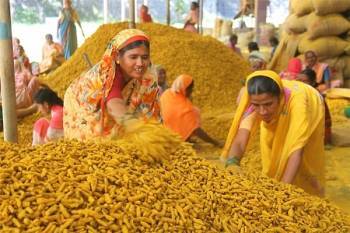MUMBAI, 12 May 2025: Commodity traders today face many challenges like earthquakes, rains, droughts, recessions, money crunch, and bankruptcy, and now new challenges like war and tariff wars have been added.
To fight all these challenges, the only weapon they have like S-400 is risk management, i.e. hedging. Hedging can be a protective shield like self defence system in this market volatility. This time, since the cultivation of turmeric in India has increased by 22.50 percent, there was an expectation that the crop will increase and the price will come down when new arrivals start.
In addition, due to the war against Pakistan, air borders are now under control, and exports to the Gulf countries are expected to become expensive. The decrease in prices has also been seen due to the worry of reduced exports. In these times of such irregularity, there will be relief for traders and farmers who have hedged their profits in futures or options on exchange platforms.
If you look at the graph of NCDEX futures prices, you can understand that the market is currently full of irregularities. In two months, the price of turmeric has fluctuated by up to INR 5000 per quintal. On March 13, the price of turmeric per quintal was INR 11300, which increased to INR 15970 on April 22.
But then, due to concerns about the escalation of tense with Pakistan, the price fell again to INR 13125 on May 9. As 35 to 40 percent of our country's total production is exported, it is obvious that the price is affected in such difficult times.
The average daily arrivals in the spot market last week were 13,803 tonnes, which is higher than the arrivals of the last three years. This is an indication that traders do not want to take too much risk. In the last week, more arrivals were seen in Marathwada, Basmat, Hingoli and Sangli region. There are also reports of unseasonal rain in some areas. However, most of the turmeric crop is already harvested and less in the fields, the impact of rains has not been seen on the prices.
Earlier, the commercial survey had said that this time turmeric has been sown in 1.82 lakh hectares, which was recorded in 1.49 lakh hectares last year. On the other hand, the Spice Board figures claim that it has been sown in 3.05 lakh hectares. Every time the Spice Board figures are higher than the market survey. According to Spice Board data, in the last three years, India has produced between 10.75 lakh tonnes and 12.22 lakh tonnes of turmeric.
Since last January 2025, some farmers had bought turmeric put options on the Exchange platform. In March 2025, there were about 1100 tonnes of open Interest of Put options. At that time, the farmers who had paid a premium of up to INR 1800 per quintal might have felt it very costly. But when the time came for delivery, the price difference was up to INR 3000 per quintal. As a result, the farmers who had position of put options got a good profit overall.
There are certain facts of the commodity business that the slowdown and bull run are part of the trade and market bounce back at the same speed. It should also be remembered here that turmeric has medicinal properties. Therefore, it does not spoil quickly. So, if farmers do not get the price as per their expectations, they have a choice of storage and wait for some time.
By Kalpesh Sheth - an comodities expert with years of experience.
Image credit: commodity-board.com




















